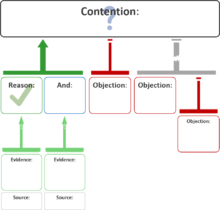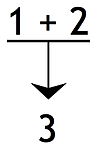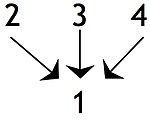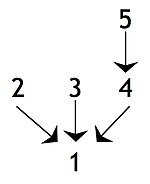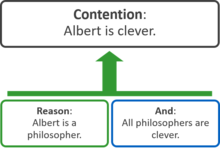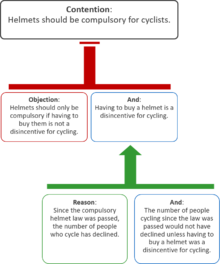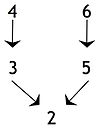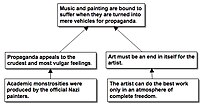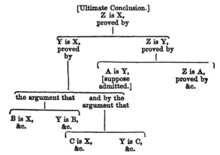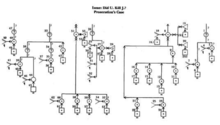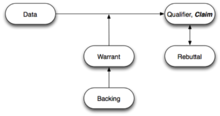From Wikipedia, the free encyclopedia
Starting
from a young age, people can make moral decisions about what is right
and wrong. Moral reasoning, however, is a part of morality that occurs
both within and between individuals. Prominent contributors to this theory include Lawrence Kohlberg and Elliot Turiel.
The term is sometimes used in a different sense: reasoning under
conditions of uncertainty, such as those commonly obtained in a court of law. It is this sense that gave rise to the phrase, "To a moral certainty;" however, this idea is now seldom used outside of charges to juries.
Moral reasoning is an important and often daily process that
people use when trying to do the right thing. For instance, every day
people are faced with the dilemma of whether to lie in a given situation
or not. People make this decision by reasoning the morality of their
potential actions, and through weighing their actions against potential
consequences.
A moral choice can be a personal, economic, or ethical one; as described by some ethical code, or regulated by ethical relationships
with others. This branch of psychology is concerned with how these
issues are perceived by ordinary people, and so is the foundation of
descriptive ethics. There are many different forms of moral reasoning
which often are dictated by culture. Cultural differences in the
high-levels of cognitive function associated with moral reasoning can be
observed through the association of brain networks from various
cultures and their moral decision making. These cultural differences
demonstrate the neural basis that cultural influences can have on an
individual's moral reasoning and decision making.
Distinctions between theories of moral reasoning can be accounted for by evaluating inferences (which tend to be either deductive or inductive) based on a given set of premises.
Deductive inference reaches a conclusion that is true based on whether a
given set of premises preceding the conclusion are also true, whereas,
inductive inference goes beyond information given in a set of premises
to base the conclusion on provoked reflection.
In philosophy
Philosopher David Hume claims that morality is based more on perceptions than on logical reasoning.
This means that people's morality is based more on their emotions and
feelings than on a logical analysis of any given situation. Hume regards
morals as linked to passion, love, happiness, and other emotions and
therefore not based on reason. Jonathan Haidt agrees, arguing in his social intuitionist model that reasoning concerning a moral situation or idea follows an initial intuition.
Haidt's fundamental stance on moral reasoning is that "moral intuitions
(including moral emotions) come first and directly cause moral
judgments"; he characterizes moral intuition as "the sudden appearance
in consciousness of a moral judgment, including an affective valence
(good-bad, like-dislike), without any conscious awareness of having gone
through steps of searching, weighing evidence, or inferring a
conclusion".
Immanuel Kant
had a radically different view of morality. In his view, there are
universal laws of morality that one should never break regardless of
emotions.
He proposes a four-step system to determine whether or not a given
action was moral based on logic and reason. The first step of this
method involves formulating "a maxim capturing your reason for an
action". In the second step, one "frame[s] it as a universal principle for all rational agents". The third step is assessing "whether a world based on this universal principle is conceivable". If it is, then the fourth step is asking oneself "whether [one] would will the maxim to be a principle in this world".
In essence, an action is moral if the maxim by which it is justified is
one which could be universalized. For instance, when deciding whether
or not to lie to someone for one's own advantage, one is meant to
imagine what the world would be like if everyone always lied, and
successfully so. In such a world, there would be no purpose in lying,
for everybody would expect deceit, rendering the universal maxim of
lying whenever it is to your advantage absurd. Thus, Kant argues that
one should not lie under any circumstance. Another example would be if
trying to decide whether suicide is moral or immoral; imagine if
everyone committed suicide. Since mass international suicide would not
be a good thing, the act of suicide is immoral. Kant's moral framework,
however, operates under the overarching maxim that you should treat each
person as an end in themselves, not as a means to an end. This
overarching maxim must be considered when applying the four
aforementioned steps.
Reasoning based on analogy
is one form of moral reasoning. When using this form of moral reasoning
the morality of one situation can be applied to another based on
whether this situation is relevantly similar: similar enough that the same moral reasoning applies. A similar type of reasoning is used in common law when arguing based upon legal precedent.
In consequentialism (often distinguished from deontology)
actions are based as right on wrong based upon the consequences of
action as opposed to a property intrinsic to the action itself.
In developmental psychology
Moral
reasoning first attracted a broad attention from developmental
psychologists in the mid-to-late 20th century. Their main theorization
involved elucidating the stages of development of moral reasoning
capacity.
Jean Piaget
Jean Piaget
developed two phases of moral development, one common among children
and the other common among adults. The first is known as the
Heteronomous Phase.
This phase, more common among children, is characterized by the idea
that rules come from authority figures in one's life such as parents,
teachers, and God. It also involves the idea that rules are permanent no matter what.
Thirdly, this phase of moral development includes the belief that
"naughty" behavior must always be punished and that the punishment will
be proportional.
The second phase in Piaget's theory of moral development is
referred to as the Autonomous Phase. This phase is more common after
one has matured and is no longer a child. In this phase people begin to
view the intentions behind actions as more important than their
consequences.
For instance, if a person who is driving swerves in order to not hit a
dog and then knocks over a road sign, adults are likely to be less angry
at the person than if he or she had done it on purpose just for fun.
Even though the outcome is the same, people are more forgiving because
of the good intention of saving the dog. This phase also includes the
idea that people have different morals and that morality is not
necessarily universal. People in the Autonomous Phase also believe rules may be broken under certain circumstances. For instance, Rosa Parks
broke the law by refusing to give up her seat on a bus, which was
against the law but something many people consider moral nonetheless. In
this phase people also stop believing in the idea of immanent justice.
Lawrence Kohlberg
Inspired by Piaget, Lawrence Kohlberg made significant contributions to the field of moral reasoning by creating a theory of moral development.
His theory is a "widely accepted theory that provides the basis for
empirical evidence on the influence of human decision making on ethical
behavior."
In Lawrence Kohlberg's view, moral development consists of the growth
of less egocentric and more impartial modes of reasoning on more
complicated matters. He believed that the objective of moral education
is the reinforcement of children to grow from one stage to an upper
stage. Dilemma was a critical tool that he emphasized that children
should be presented with; yet also, the knowledge for children to
cooperate.
According to his theory, people pass through three main stages of moral
development as they grow from early childhood to adulthood. These are
pre-conventional morality, conventional morality, and post-conventional
morality. Each of these is subdivided into two levels.
The first stage in the pre-conventional level is obedience and
punishment. In this stage people, usually young children, avoid certain
behaviors only because of the fear of punishment, not because they see
them as wrong.
The second stage in the pre-conventional level is called individualism
and exchange: in this stage people make moral decisions based on what
best serves their needs.
The third stage is part of the conventional morality level and is
called interpersonal relationships. In this stage one tries to conform
to what is considered moral by the society that they live in, attempting
to be seen by peers as a good person.
The fourth stage is also in the conventional morality level and is
called maintaining social order. This stage focuses on a view of
society as a whole and following the laws and rules of that society.
The fifth stage is a part of the post-conventional level and is
called social contract and individual rights. In this stage people begin
to consider differing ideas about morality in other people and feel
that rules and laws should be agreed on by the members of a society.
The sixth and final stage of moral development, the second in the
post-conventional level, is called universal principles. At this stage
people begin to develop their ideas of universal moral principles and
will consider them the right thing to do regardless of what the laws of a
society are.
James Rest
In
1983, James Rest developed the four component Model of Morality, which
addresses the ways that moral motivation and behavior occurs.
The first of these is moral sensitivity, which is "the ability to see
an ethical dilemma, including how our actions will affect others". The second is moral judgment, which is "the ability to reason correctly about what 'ought' to be done in a specific situation". The third is moral motivation, which is "a personal commitment to moral action, accepting responsibility for the outcome". The fourth and final component of moral behavior is moral character, which is a "courageous persistence in spite of fatigue or temptations to take the easy way out".
In social cognition
Based
on empirical results from behavioral and neuroscientific studies,
social and cognitive psychologists attempted to develop a more accurate descriptive (rather than normative) theory of moral reasoning.
That is, the emphasis of research was on how real-world individuals
made moral judgments, inferences, decisions, and actions, rather than
what should be considered as moral.
Dual-process theory and social intuitionism
Developmental theories of moral reasoning were critiqued as
prioritizing on the maturation of cognitive aspect of moral reasoning.
From Kohlberg's perspective, one is considered as more advanced in
moral reasoning as she is more efficient in using deductive reasoning
and abstract moral principles to make moral judgments about particular
instances. For instance, an advanced reasoner may reason syllogistically with the Kantian principle
of 'treat individuals as ends and never merely as means' and a
situation where kidnappers are demanding a ransom for a hostage, to
conclude that the kidnappers have violated a moral principle and should
be condemned. In this process, reasoners are assumed to be rational and
have conscious control over how they arrive at judgments and decisions.
In contrast with such view, however, Joshua Greene
and colleagues argued that laypeople's moral judgments are
significantly influenced, if not shaped, by intuition and emotion as
opposed to rational application of rules. In their fMRI studies in the
early 2000s,
participants were shown three types of decision scenarios: one type
included moral dilemmas that elicited emotional reaction (moral-personal
condition), the second type included moral dilemmas that did not elicit
emotional reaction (moral-impersonal condition), and the third type had
no moral content (non-moral condition). Brain regions such as posterior
cingulate gyrus and angular gyrus, whose activation is known to
correlate with experience of emotion, showed activations in
moral-personal condition but not in moral-impersonal condition.
Meanwhile, regions known to correlate with working memory, including
right middle frontal gyrus and bilateral parietal lobe, were less active
in moral-personal condition than in moral-impersonal condition.
Moreover, participants' neural activity in response to moral-impersonal
scenarios was similar to their activity in response to non-moral
decision scenarios.
Another study used variants of trolley problem
that differed in the 'personal/impersonal' dimension and surveyed
people's permissibility judgment (Scenarios 1 and 2). Across scenarios,
participants were presented with the option of sacrificing a person to
save five people. However, depending on the scenario, the sacrifice
involved pushing a person off a footbridge to block the trolley
(footbridge dilemma condition; personal) or simply throwing a switch to
redirect the trolley (trolley dilemma condition; impersonal). The
proportions of participants who judged the sacrifice as permissible
differed drastically: 11% (footbridge dilemma) vs. 89% (trolley
dilemma). This difference was attributed to the emotional reaction
evoked from having to apply personal force on the victim, rather than
simply throwing a switch without physical contact with the victim.
Focusing on participants who judged the sacrifice in trolley dilemma as
permissible but the sacrifice in footbridge dilemma as impermissible,
the majority of them failed to provide a plausible justification for
their differing judgments. Several philosophers have written critical responses on this matter to Joshua Greene and colleagues.
Based on these results, social psychologists proposed the dual process theory of morality.
They suggested that our emotional intuition and deliberate reasoning
are not only qualitatively distinctive, but they also compete in making
moral judgments and decisions. When making an emotionally-salient moral
judgment, automatic, unconscious, and immediate response is produced by
our intuition first. More careful, deliberate, and formal reasoning then
follows to produce a response that is either consistent or inconsistent
with the earlier response produced by intuition, in parallel with more general form of dual process theory of thinking.
But in contrast with the previous rational view on moral reasoning, the
dominance of the emotional process over the rational process was
proposed.
Haidt highlighted the aspect of morality not directly accessible by our
conscious search in memory, weighing of evidence, or inference. He
describes moral judgment as akin to aesthetic judgment, where an instant
approval or disapproval of an event or object is produced upon
perception.
Hence, once produced, the immediate intuitive response toward a
situation or person cannot easily be overridden by the rational
consideration that follows. The theory explained that in many cases,
people resolve inconsistency between the intuitive and rational
processes by using the latter for post-hoc justification of the former.
Haidt, using the metaphor "the emotional dog and its rational tail", applied such nature of our reasoning to the contexts ranging from person perception to politics.
A notable illustration of the influence of intuition involved feeling of disgust. According to Haidt's moral foundations theory,
political liberals rely on two dimensions (harm/care and
fairness/reciprocity) of evaluation to make moral judgments, but
conservatives utilize three additional dimensions (ingroup/loyalty,
authority/respect, and purity/sanctity).
Among these, studies have revealed the link between moral evaluations
based on purity/sanctity dimension and reasoner's experience of disgust.
That is, people with higher sensitivity to disgust were more likely to
be conservative toward political issues such as gay marriage and
abortion.
Moreover, when the researchers reminded participants of keeping the lab
clean and washing their hands with antiseptics (thereby priming the
purity/sanctity dimension), participants' attitudes were more
conservative than in the control condition. In turn, Helzer and Pizarro's findings have been rebutted by two failed attempts of replications.
Other studies raised criticism toward Haidt's interpretation of his data.
Augusto Blasi also rebuts the theories of Jonathan Haidt on moral
intuition and reasoning. He agrees with Haidt that moral intuition plays
a significant role in the way humans operate. However, Blasi suggests
that people use moral reasoning more than Haidt and other cognitive
scientists claim. Blasi advocates moral reasoning and reflection as the
foundation of moral functioning. Reasoning and reflection play a key
role in the growth of an individual and the progress of societies.
Alternatives to these dual-process/intuitionist models have been
proposed, with several theorists proposing that moral judgment and moral
reasoning involves domain general cognitive processes, e.g., mental
models, social learning or categorization processes.
Motivated reasoning
A theorization of moral reasoning similar to dual-process theory was
put forward with emphasis on our motivations to arrive at certain
conclusions. Ditto and colleagues
likened moral reasoners in everyday situations to lay attorneys than
lay judges; people do not reason in the direction from assessment of
individual evidence to moral conclusion (bottom-up), but from a
preferred moral conclusion to assessment of evidence (top-down). The
former resembles the thought process of a judge who is motivated to be
accurate, unbiased, and impartial in her decisions; the latter resembles
that of an attorney whose goal is to win a dispute using partial and
selective arguments.
Kunda proposed motivated reasoning as a general framework for understanding human reasoning.
She emphasized the broad influence of physiological arousal, affect,
and preference (which constitute the essence of motivation and cherished
beliefs) on our general cognitive processes including memory search and
belief construction. Importantly, biases in memory search, hypothesis
formation and evaluation result in confirmation bias,
making it difficult for reasoners to critically assess their beliefs
and conclusions. It is reasonable to state that individuals and groups
will manipulate and confuse reasoning for belief depending on the lack
of self control to allow for their confirmation bias to be the driving
force of their reasoning. This tactic is used by media, government,
extremist groups, cults, etc. Those with a hold on information may dull
out certain variables that propagate their agenda and then leave out
specific context to push an opinion into the form of something
reasonable to control individual, groups, and entire populations. This
allows the use of alternative specific context with fringe content to
further veer from any form of dependability in their reasoning. Leaving a
fictional narrative in the place of real evidence for a logical outlook
to form a proper, honest, and logical assessment.
Applied to moral domain, our strong motivation to favor people we
like leads us to recollect beliefs and interpret facts in ways that
favor them. In Alicke (1992, Study 1),
participants made responsibility judgments about an agent who drove
over the speed limit and caused an accident. When the motive for
speeding was described as moral (to hide a gift for his parents'
anniversary), participants assigned less responsibility to the agent
than when the motive was immoral (to hide a vial of cocaine). Even
though the causal attribution of the accident may technically fall under
the domain of objective, factual understanding of the event, it was
nevertheless significantly affected by the perceived intention of the
agent (which was presumed to have determined the participants'
motivation to praise or blame him).
Another paper by Simon, Stenstrom, and Read (2015, Studies 3 and 4)
used a more comprehensive paradigm that measures various aspects of
participants' interpretation of a moral event, including factual
inferences, emotional attitude toward agents, and motivations toward the
outcome of decision. Participants read about a case involving a
purported academic misconduct and were asked to role-play as a judicial
officer who must provide a verdict. A student named Debbie had been
accused of cheating in an exam, but the overall situation of the
incident was kept ambiguous to allow participants to reason in a desired
direction. Then, the researchers attempted to manipulate participants'
motivation to support either the university (conclude that she cheated)
or Debbie (she did not cheat) in the case. In one condition, the
scenario stressed that through previous incidents of cheating, the
efforts of honest students have not been honored and the reputation of
the university suffered (Study 4, Pro-University condition); in another
condition, the scenario stated that Debbie's brother died from a tragic
accident a few months ago, eliciting participants' motivation to support
and sympathize with Debbie (Study 3, Pro-Debbie condition). Behavioral
and computer simulation results showed an overall shift in
reasoning--factual inference, emotional attitude, and moral
decision--depending on the manipulated motivation. That is, when the
motivation to favor the university/Debbie was elicited, participants'
holistic understanding and interpretation of the incident shifted in the
way that favored the university/Debbie. In these reasoning processes,
situational ambiguity was shown to be critical for reasoners to arrive
at their preferred conclusion.
From a broader perspective, Holyoak
and Powell interpreted motivated reasoning in the moral domain as a
special pattern of reasoning predicted by coherence-based reasoning
framework. This general framework of cognition, initially theorized by the philosopher Paul Thagard,
argues that many complex, higher-order cognitive functions are made
possible by computing the coherence (or satisfying the constraints)
between psychological representations such as concepts, beliefs, and
emotions.
Coherence-based reasoning framework draws symmetrical links between
consistent (things that co-occur) and inconsistent (things that do not
co-occur) psychological representations and use them as constraints,
thereby providing a natural way to represent conflicts between
irreconcilable motivations, observations, behaviors, beliefs, and
attitudes, as well as moral obligations.
Importantly, Thagard's framework was highly comprehensive in that it
provided a computational basis for modeling reasoning processes using
moral and non-moral facts and beliefs as well as variables related to
both 'hot' and 'cold' cognitions.
Causality and intentionality
Classical theories of social perception had been offered by psychologists including Fritz Heider (model of intentional action) and Harold Kelley (attribution theory).
These theories highlighted how laypeople understand another person's
action based on their causal knowledge of internal (intention and
ability of actor) and external (environment) factors surrounding that
action. That is, people assume a causal relationship between an actor's
disposition or mental states (personality, intention, desire, belief,
ability; internal cause), environment (external cause), and the
resulting action (effect). In later studies, psychologists discovered
that moral judgment toward an action or actor is critically linked with
these causal understanding and knowledge about the mental state of the
actor.
Bertram Malle and Joshua Knobe
conducted survey studies to investigate laypeople's understanding and
use (the folk concept) of the word 'intentionality' and its relation to
action.
His data suggested that people think of intentionality of an action in
terms of several psychological constituents: desire for outcome, belief
about the expected outcome, intention to act (combination of desire and
belief), skill to bring about the outcome, and awareness of action while
performing that action. Consistent with this view as well as with our
moral intuitions, studies found significant effects of the agent's
intention, desire, and beliefs on various types of moral judgments,
Using factorial designs to manipulate the content in the scenarios,
Cushman showed that the agent's belief and desire regarding a harmful
action significantly influenced judgments of wrongness, permissibility,
punishment, and blame. However, whether the action actually brought
about negative consequence or not only affected blame and punishment
judgments, but not wrongness and permissibility judgments. Another study also provided neuroscientific evidence for the interplay between theory of mind and moral judgment.
Through another set of studies, Knobe showed a significant effect
in the opposite direction: Intentionality judgments are significantly
affected by the reasoner's moral evaluation of the actor and action.
In one of his scenarios, a CEO of a corporation hears about a new
programme designed to increase profit. However, the program is also
expected to benefit or harm the environment as a side effect, to which
he responds by saying 'I don't care'. The side effect was judged as
intentional by the majority of participants in the harm condition, but
the response pattern was reversed in the benefit condition.
Many studies on moral reasoning have used fictitious scenarios involving anonymous strangers (e.g., trolley problem)
so that external factors irrelevant to researcher's hypothesis can be
ruled out. However, criticisms have been raised about the external
validity of the experiments in which the reasoners (participants) and
the agent (target of judgment) are not associated in any way.
As opposed to the previous emphasis on evaluation of acts, Pizarro and
Tannenbaum stressed our inherent motivation to evaluate the moral
characters of agents (e.g., whether an actor is good or bad), citing the
Aristotelian virtue ethics.
According to their view, learning the moral character of agents around
us must have been a primary concern for primates and humans beginning
from their early stages of evolution, because the ability to decide whom
to cooperate with in a group was crucial to survival.
Furthermore, observed acts are no longer interpreted separately from
the context, as reasoners are now viewed as simultaneously engaging in
two tasks: evaluation (inference) of moral character of agent and
evaluation of her moral act. The person-centered approach to moral
judgment seems to be consistent with results from some of the previous
studies that involved implicit character judgment. For instance, in
Alicke's (1992)
study, participants may have immediately judged the moral character of
the driver who sped home to hide cocaine as negative, and such inference
led the participants to assess the causality surrounding the incident
in a nuanced way (e.g., a person as immoral as him could have been
speeding as well).
In order to account for laypeople's understanding and use of
causal relations between psychological variables, Sloman, Fernbach, and
Ewing proposed a causal model of intentionality judgment based on Bayesian network.
Their model formally postulates that character of agent is a cause for
the agent's desire for outcome and belief that action will result in
consequence, desire and belief are causes for intention toward action,
and the agent's action is caused by both that intention and the skill
to produce consequence. Combining computational modeling with the ideas
from theory of mind
research, this model can provide predictions for inferences in
bottom-up direction (from action to intentionality, desire, and
character) as well as in top-down direction (from character, desire, and
intentionality to action).
Gender difference
At
one time psychologists believed that men and women have different moral
values and reasoning. This was based on the idea that men and women
often think differently and would react to moral dilemmas in different
ways. Some researchers hypothesized that women would favor care
reasoning, meaning that they would consider issues of need and
sacrifice, while men would be more inclined to favor fairness and
rights, which is known as justice reasoning.
However, some also knew that men and women simply face different moral
dilemmas on a day-to-day basis and that might be the reason for the
perceived difference in their moral reasoning.
With these two ideas in mind, researchers decided to do their
experiments based on moral dilemmas that both men and women face
regularly. To reduce situational differences and discern how both
genders use reason in their moral judgments, they therefore ran the
tests on parenting situations, since both genders can be involved in
child rearing.
The research showed that women and men use the same form of moral
reasoning as one another and the only difference is the moral dilemmas
they find themselves in on a day-to-day basis.
When it came to moral decisions both men and women would be faced
with, they often chose the same solution as being the moral choice. At
least this research shows that a division in terms of morality does not
actually exist, and that reasoning between genders is the same in moral
decisions.

